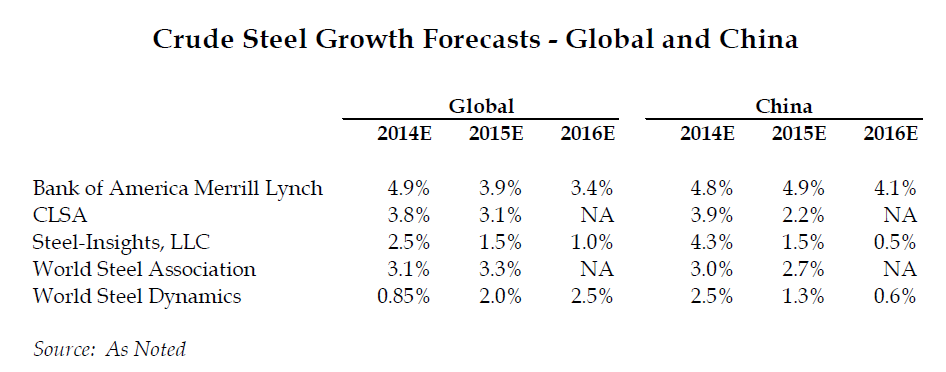Steel Mills

Where is Steel Capacity Headed?
Written by Sandy Williams
July 7, 2014
“Following the doubling of steel production from 849 million tonnes in 2000 to 1.6 million tonnes in 2014, we are likely entering a period of consolidation, or at the very least, much reduced growth.”
That is the opinion of Becky Hites, analyst and president of Steel-Insights, LLC in a June 7, 2014 report, Fixed Asset Investment Flywheel: Spinning Slower But Not Stopping Just Yet.
In a quick look around the globe, Hites finds steel consumption beginning to level off in China. The impact of the 2008 financial crisis is still being felt in Europe and to a lesser extent in North American and Latin America. Japan production has fallen off due to the pressure on power supplies from the earthquake and tsunami. Capacity continues to grow in Turkey with much of the increase oriented towards exports to the US and Europe. India and the Middle East showed strong steel production growth in 2013.
Nearly 28 percent of steel produced globally is exported to somewhere else. The mix of long to flat products has evened out in the last five years from a long to flat ratio of 47-48%/52-53% to a current mix of 49-52%/48-51%, wrote Hites.
Global Steel Capacity
Currently the global steel industry produces 2.1 billion tonnes of steel annually compared to a demand of 1.7-1.8 billion tonnes, creating an overcapacity of 300-400 million tons.
Half of that overcapacity can be attributed to China which exports around 65 million tonnes of its steel. That still leaves 200 million tonnes of excess capacity outside of China for a production utilization rate of about 80 percent which is keeping “pressure on pricing as too many tonnes chase too little demand.”
 China Steel Industry
China Steel Industry
China is experiencing less support from the government with fewer permits authorized for new facility construction, stringent environmental regulations which are closing older plants, and tighter financing availability for mills and traders.
“In China, the steel mills sell to 96,000 traders who then sell the steel to consumers, which causes a bit of a disconnect in market feedback,” writes Hites. “Until recently, there was no cost of capital associated with holding the steel in inventory, so the traders would become speculators and continue to accumulate product as long as they thought they would be able to sell the holdings later for a higher price.”
Slowing growth in Chinese has let raw material supply catch up with global steel demand leading to a drop pricing for coal and iron ore. This has resulted in “removing the price support finished steel products had enjoyed for the past decade.”
Capital Investments Continue Despite Overcapacity
Technological advances, writes Hites, have stimulated a push to build new or modernize old plants into low production cost, state-of-the-art facilities.
In most cases, writes Hites, new capacity is being added in countries that are experiencing steel consumption growth. The exceptions are the construction of EAF mill Big River Steel in Arkansas and the restart of Sahaviriya’s Teeside mill in the UK. Hites notes that over 20 large expansion projects were listed by Metal Expert’s twitter feed in May, not including the half dozen or more pipe and tube projects in the US.
Key Market Drivers for Capital Investment
In developing countries, writes Hites, expansion is tied to the need for employment and a national pride in becoming self sustaining, often part of a government agenda to improve the economic stability of their nation.
In developed countries the expansion emphasis is on becoming more modern, reducing costs and producing higher grade products. Mills strive to be net exporters of longs, flats or tube and pipe or to displace the imports of those three products. Expansion and modernization is also driven by the necessity to comply with environmental regulations.
Looking towards the near future, Hites suggests the steel industry take a ““moderately defensive position, a focus on reducing your manufacturing cost, and where possible the operating cost of your customers, with an eye to opportunistic expansion.”
Becky Hites, a global steel industry professional is scheduled to speak on the transition of China to the consumer based economy at the Steel Market Update Steel Summit Conference, September 3 & 4 in Atlanta, Georgia.

Sandy Williams
Read more from Sandy WilliamsLatest in Steel Mills

Algoma fires up EAF steelmaking with first arc
Algoma Steel reached a milestone in its transformation from blast furnace to electric arc furnace (EAF) steelmaking, with its Unit One EAF achieving its first steel production this week.

Nucor holds HR list price at $910/ton
Nucor is keeping its list price for spot hot-rolled coil unchanged after last week’s shortened holiday week.

Cliffs unveils new hydrogen-powered stainless line in Ohio
CEO Lourenco Goncalves, flanked by state leaders and union reps, touted the project as proof that US manufacturing is not only alive, but also advancing.

Cliffs idles Steelton, Riverdale, and Conshohocken operations
Cliffs has idled facilities in Riverdale, Ill., and Conshohocken and Steelton, Pa.

Radius loss narrows, volumes climb in ‘healthy’ West Coast market
Stronger steel demand in the Western US, rising scrap flows, and improved rolling mill utilization drove sequential gains for Portland, Ore.-based Radius Recycling.

